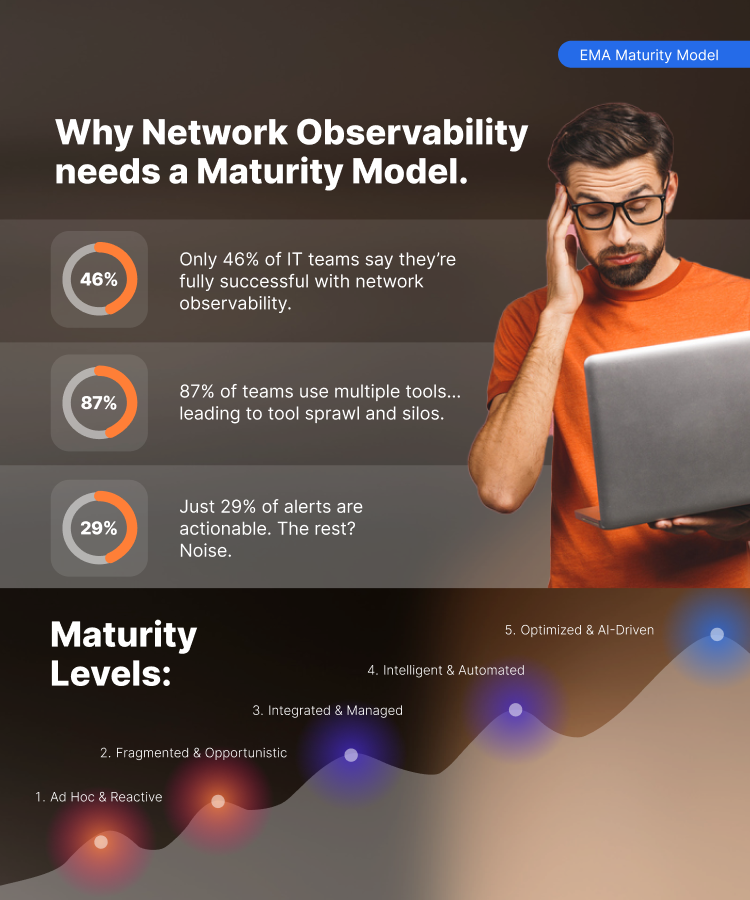Stop network chaos:
A path to mature network observability

If you’re spending more time sifting through false alerts than actually fixing issues, you’re not alone.
71% of alerts are just noise, and most teams are juggling too many tools to get a clear view of their networks.
This report breaks down what’s holding engineers back — and shows the exact steps high-maturity teams are taking to cut through the noise, see every packet, and troubleshoot faster than ever.
Download the report for a summary of findings, including:
only partially successful
with network
observability
report using multiple
network observability
tools
of alerts are actionable,
leaving excessive noise for your team
more likely to be completely
successful by integrating tools deeply
In the earliest stage, network monitoring is minimal and highly reactive.
Technologies Used
Teams rely on basic monitoring — things like SNMP, ICMP, and homegrown scripts. There’s little to no traffic visibility, and packet captures are used only after issues occur.
Operational Posture
NetOps is in firefighting mode. Visibility is limited, and problems are only addressed after users complain. Monitoring is inconsistent, leaving blind spots everywhere.
Here, teams add more coverage, but tool silos create fragmentation.
Technologies Used
Most hardware is monitored with SNMP, complemented by flow visibility (NetFlow, IPFIX). Teams might capture packets, but only ad hoc. Tools are siloed with little integration.
Operational Posture
Coverage improves, but operations are still reactive. Engineers manually stitch together data from different dashboards. Lack of customization limits insights, leaving teams struggling to connect the dots.
Stage 3 marks a turning point — monitoring becomes comprehensive and standardized.
Technologies Used
Teams achieve full SNMP and flow monitoring, with packet capture integrated into standard workflows. Monitoring expands into SD-WAN, cloud, branch offices, and remote workers.
Operational Posture
NetOps begins to measure against KPIs and SLAs, ensuring consistency. Tools are centrally integrated, enabling faster correlation and troubleshooting. The posture shifts from reactive to proactive monitoring and response.
At this stage, visibility deepens and automation takes hold.
Technologies Used
Teams use real-time performance monitoring across metrics, flows, and packets. Raw packet data is correlated with performance metrics, and monitoring extends deeper into software-defined environments like SD-WAN and cloud.
Operational Posture
NetOps embraces automation and contextual correlation. Issues are resolved faster with automated remediation, and operations become proactive rather than reactive. Collaboration grows between NetOps and SecOps on unified observability platforms.
The highest maturity level leverages AI to predict and prevent issues before they happen.
Technologies Used
Teams employ deep packet inspection, real-time analytics, and AI/ML to drive anomaly detection, predictive optimization, and security insights. Observability platforms unify NetOps and SecOps data.
Operational Posture
This stage represents continuous improvement and foresight. AI assistants and automation handle troubleshooting, remediation, and optimization. NetOps shifts from being reactive firefighters to strategic enablers of business agility.
The report provides a practical roadmap for advancing your organization’s network observability. You’ll see how peers are reducing tool sprawl, integrating AI-driven automation, and achieving real-time insights across hybrid and cloud environments.
Most importantly, you’ll learn where your team falls on the maturity curve — and the concrete steps you can take to unlock higher efficiency, faster problem resolution, and stronger business resilience.
Download the report for a summary of findings, including: